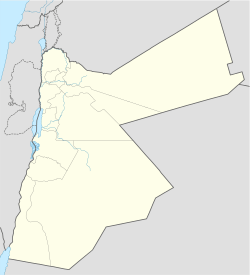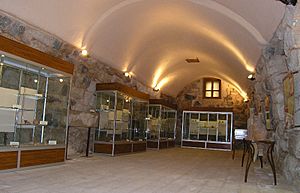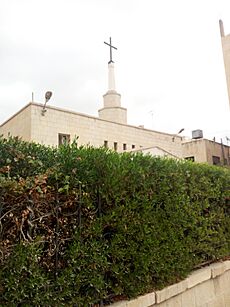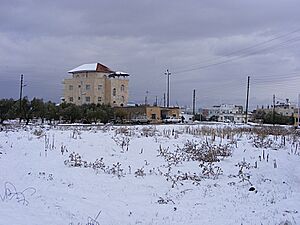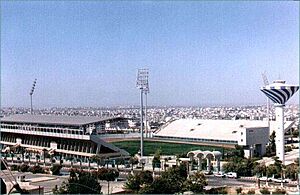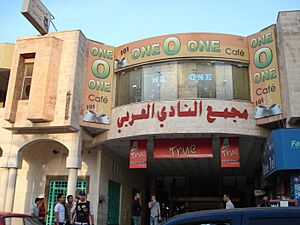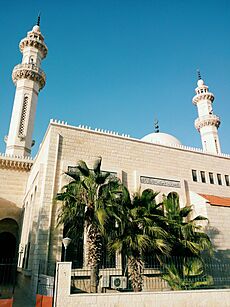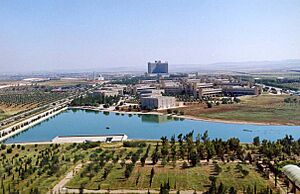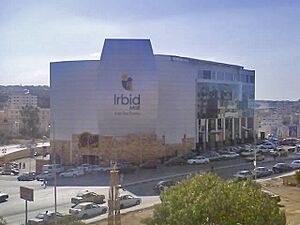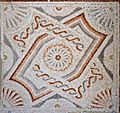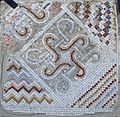Irbid facts for kids
Quick facts for kids
Irbid
إربد
|
|
|---|---|
|
City
|
|
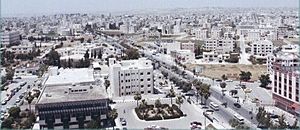 |
|
| Nickname(s):
Bride of the North
|
|
| Country | |
| Governorate | Irbid Governorate |
| Founded | 7000 BC |
| Government | |
| • Type | Municipality |
| Area | |
| • City | 410 km2 (160 sq mi) |
| • Metro | 1,572 km2 (607 sq mi) |
| Elevation | 620 m (2,034 ft) |
| Population
(2020)
|
|
| • City | 569,068 |
| • Density | 1,388/km2 (3,590/sq mi) |
| • Metro | 2,003,800 |
| Time zone | UTC+2 (GMT) |
| • Summer (DST) | +3 |
| Area code(s) | +(962)2 |
Irbid (Arabic: إِربِد) is a major city in Jordan. It's the capital of the Irbid Governorate. In ancient times, it was known as Arabella or Arbela.
Irbid is the second-largest metropolitan area in Jordan, after Amman. It has a population of about 2 million people. As a city, Irbid is the third largest in Jordan, after Amman and Zarqa.
The city is located about 70 kilometers (43 miles) north of Amman. It sits on the northern part of the Gilead region. Irbid is also close to the Syrian border, about 20 kilometers (12 miles) south.
Irbid was built on very old settlements from the Early Bronze Age. It might have been the biblical Beth Arbel. It was also part of the Decapolis, a group of ten Greek cities in the region around 2000 years ago. The city grew a lot in the late 1800s. Before 1948, it was an important place for trade.
Today, Irbid is a key transportation center. It connects Amman with Syria to the north and Mafraq to the east. The area is also famous for its many colleges and universities. The two biggest universities are Jordan University of Science and Technology and Yarmouk University.
Contents
What's in a Name?
The name Irbid likely comes from an older spelling, "Arba'el." This name was used by Jewish people and later by Arabs. Ancient Greek writings also confirm this name, sometimes adding an 'a' at the end.
A Glimpse into Irbid's Past
Evidence like old pottery and graves shows that people lived in Irbid during the Bronze Age. Pottery pieces and wall stones found at Tell Irbid are about 5,200 years old. A city wall found there dates back to around 1300-1200 BC.
During the Hellenistic period, Irbid was called Arabella. It was a very important place for trade. Before the religion of Islam arrived, Arabella was known for making some of the best wine in the ancient world. The land around Irbid was very fertile, and the weather was good for growing high-quality grapes.
After the Muslim conquests, the city became known as Irbid. It then started producing olive oil instead of wine. Wheat was also a very important crop grown in the area.
In 1838, a traveler named Eli Smith noted that Irbid was a place where Sunni Muslim people lived. By 1961, Irbid had about 44,585 residents.
Today, Irbid is a busy city. It mixes the feel of a traditional Middle Eastern town with the lively atmosphere of a college city. Many students from different countries come to study here.
Irbid is home to two interesting museums. These are the Museum of Jordanian Heritage and the Jordan Natural History Museum. Both are located at Yarmouk University. Irbid's location in northern Jordan makes it a great starting point for tourists. They can visit nearby historical sites like Umm Qais, Pella, and Ajloun.
Irbid's Location and Landscape
Irbid is in northern Jordan, on a flat, fertile area called a plateau. In 2010, the city covered an area of 30 square kilometers (11.6 square miles). Most of this area (74.3%) was for homes. Other parts were for services (9.5%), empty land (7.7%), shops (4.2%), and factories (3.3%). Gardens made up 1% of the city.
Neighboring Cities
Irbid is close to several other cities:
- Um Qais
- Al Koura
- Mafraq
- Ar Ramtha
Weather in Irbid
Irbid has a hot-summer Mediterranean climate. This means summers are hot during the day and warm at night. Winters are cool and wet. It usually snows about two days a year.
| Climate data for Irbid (1985–2014) | |||||||||||||
|---|---|---|---|---|---|---|---|---|---|---|---|---|---|
| Month | Jan | Feb | Mar | Apr | May | Jun | Jul | Aug | Sep | Oct | Nov | Dec | Year |
| Mean daily maximum °C (°F) | 13.4 (56.1) |
14.3 (57.7) |
17.7 (63.9) |
22.8 (73.0) |
27.2 (81.0) |
30.0 (86.0) |
31.5 (88.7) |
31.8 (89.2) |
30.1 (86.2) |
26.7 (80.1) |
20.7 (69.3) |
15.5 (59.9) |
23.5 (74.3) |
| Daily mean °C (°F) | 9.35 (48.83) |
10.0 (50.0) |
12.85 (55.13) |
17.9 (64.2) |
21.05 (69.89) |
23.95 (75.11) |
25.8 (78.4) |
26.15 (79.07) |
24.55 (76.19) |
21.25 (70.25) |
15.6 (60.1) |
11.1 (52.0) |
18.30 (64.93) |
| Mean daily minimum °C (°F) | 5.3 (41.5) |
5.7 (42.3) |
8.0 (46.4) |
11.3 (52.3) |
14.9 (58.8) |
17.9 (64.2) |
20.1 (68.2) |
20.5 (68.9) |
19.0 (66.2) |
15.8 (60.4) |
10.5 (50.9) |
6.7 (44.1) |
13 (55) |
| Average precipitation mm (inches) | 101.5 (4.00) |
110.5 (4.35) |
69.6 (2.74) |
20 (0.8) |
6.4 (0.25) |
1.6 (0.06) |
0.0 (0.0) |
0.0 (0.0) |
0.7 (0.03) |
13.9 (0.55) |
58.4 (2.30) |
81.9 (3.22) |
464.5 (18.3) |
| Average precipitation days | 11.3 | 10.6 | 9.4 | 4.6 | 2.0 | 0.2 | 0.0 | 0.0 | 0.2 | 3.2 | 6.0 | 9.6 | 57.1 |
| Source: Jordan Meteorological Department | |||||||||||||
City Districts and Nearby Villages
Irbid is divided into 23 city districts. These are like smaller towns within the larger Irbid area.
| District | District | District | |||
|---|---|---|---|---|---|
| 1 | Al'al | 9 | Foa'ra | 17 | Maru |
| 2 | Al Husn | 10 | Hakama | 18 | Mughayer |
| 3 | Al-Rabia | 11 | Hashemiyah | 19 | Naser |
| 4 | Al-Sareeh | 12 | Hawar | 20 | Rowdah |
| 5 | Barha | 13 | Huwwarah | 21 | Sal Area |
| 6 | Beit Ras | 14 | Kitim | 22 | Nu'aimah |
| 7 | Bushra (Jordan) | 15 | Kufr Jayez | 23 | Nuzha |
| 8 | Edun | 16 | Manarah ( hatim ) |
Many villages also surround the city of Irbid, including:
- Birqish-Kufr Rakeb
- Aṭ-Ṭaībah
- Natfeh
- Habaka
- Kufr-Rahta
- Al-Mazar Al-Shamali
- Hareema
- Al'aal
- Kufr Asad
- Kufr Aan
- Jumha
- Kufryuba
- Zahar
- Qum
- Sammou'
- Izmal
- Kufrelma
- Sawm
- Saydoor
- Kufr Soom
- Sama al-Rousan
- Ibser Abu Ali
- Assarieh
- Aidoon
- Al Husn
- Baleela
- Beit Ras
- Dowgarah
- En-Nu`aymeh
- Houfa Al-Westiyyah
- Qumaim
- Bushra (Jordan)
- Huwwarah
- Imrawah
- Al Ramtha
- Sal
- Samad
- Al Shajara
- Al Turrah
- Fou'ara
- Zoubia
- Jdaita
- Rehaba
- Kufor Alma
- Kharja
- Dair Yousef
- Dair Abos'eed
- Kufor Kefia
- Summer
- E'nbeh
- Bayt Yafa
- Dair Esse'neh
- Mandah
- Maru (Irbid)
- Zabda
- Bait Idis
- Makhraba
- Al-Murajjam
- Al Mughayer
Hospitals in Irbid
Irbid has many hospitals that provide healthcare for its residents and the surrounding areas. Some of them include:
- Abu Obaida Hospital
- Al-Najah Hospital
- Al-Qawasmi Hospital
- Al-Ramtha Hospital
- Al-Yarmouk Hospital
- Ibn-Alnafees Hospital
- Irbid Islamic Hospital
- Irbid Speciality Hospital
- King Abdullah University Hospital
- Muaath Bin Jabal Hospital
- Princess Badeea Hospital
- Princess Basma Hospital
- Princess Rahma Hospital
- Princess Raya Hospital
- Rahbat Al-Wardieh Hospital
- Roman Catholic Hospital
Education: A City of Learning
Irbid is a big center for education. In 2007, there were 70,000 students in its 10 universities and colleges. About 8,000 of these students came from 47 different countries! This large number of schools has really shaped the city's unique feel. The main universities in Irbid are:
- Yarmouk University
- Jordan University of Science and Technology
- Irbid National University
- Al-Balqa` Applied University (Irbid campus)
- Jadara University
There are also many private schools in Irbid, such as:
- Adventist School
- Al-Arabiya Model School
- Al-Manara Schools
- Al-Nahda Private School
- Alwatany center
- American University School of the Middle East
- Dar Al Uloum Schools
- Greek Catholic School
- Irbid International Schools
- Irbid Model School
- Islamic School (Al-Madares Al-Islamiya)
- Jeel Al Jadeed School
- Jordan National Schools
- Khawla Bint Alazwar
- Rosary Sisters School
- Shoa'a Alammel School
- Yarmouk University Model School
- Al Sareeh Secondary School For girls
Economy: How Irbid Works
Most of Irbid's economy is based on services. This means jobs related to the many universities and colleges in the city. For example, there are 26 book publishing companies in Irbid. The city even holds a Guinness Book of World Records title for having the most internet cafes per person in the world! Irbid is often called the cultural capital of Jordan. There is also a special industrial area in Irbid called a Qualifying Industrial Zone.
Sports and Culture
Irbid has a strong sports scene. The local football club, Al-Hussein (Irbid), is one of the top teams in Jordan. They play their home games at Prince Hasan Youth City's Stadium. Another important football club is Al-Arabi, which started in 1945. It's one of the oldest sports clubs in the country. In 2008, Irbid had 22 registered cultural and sports clubs. Irbid also hosted the 1999 Pan Arab Games.
Sister Cities
Irbid has "sister city" relationships with other cities around the world. This helps build friendships and cultural exchange.
Famous People from Irbid
Images for kids
See also
 In Spanish: Irbid para niños
In Spanish: Irbid para niños


